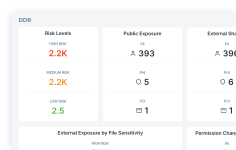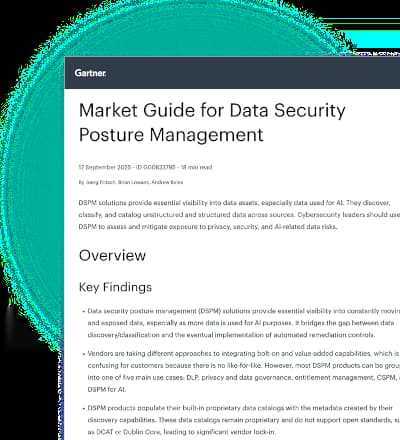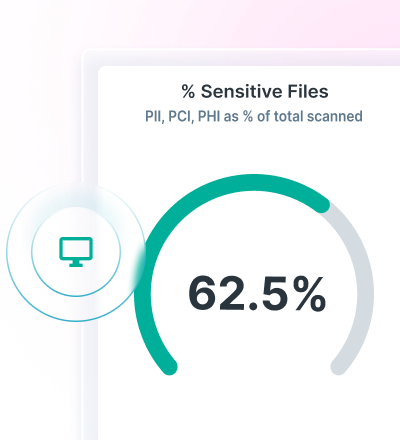What is Shadow AI and How to Stop It
0 min read

Bryan Arnott
Z. G.
Shadow AI refers to employees or teams using artificial intelligence tools or models without IT approval or security oversight. It often begins as a harmless shortcut such as asking ChatGPT for help with an email, summarizing meeting notes or generating code, but it can quickly introduce serious data risk.
Our research shows that unsanctioned AI use can expose confidential information, intellectual property and customer data to external systems that retain and reuse input data. What seems like a productivity boost can unintentionally transfer sensitive data to public AI models that operate outside corporate control.
As organizations accelerate their use of AI, they must also confront this hidden risk: enabling innovation while keeping data visibility and compliance intact.
Why Shadow AI Is a Growing Risk
Shadow AI is not only a compliance issue; it is a data-visibility problem. When employees use AI tools that fall outside approved platforms, sensitive information can move beyond the reach of governance controls and DLP policies.
Here are several mechanisms through which Shadow AI introduces risk:
- Prompt-injection attacks can trick generative models into revealing sensitive information or executing unintended actions.
- Persistent model memory allows AI systems to retain user input for training, creating long-term exposure even after the session ends.
- Insecure third-party integrations often connect directly to internal data repositories or collaboration tools, bypassing access controls.
- Opaque model behavior prevents organizations from knowing where their data goes or how it is used.
These issues are not theoretical. Attackers already exploit AI interfaces to exfiltrate data or manipulate responses. Meanwhile, legitimate users unintentionally feed confidential information into models that store it indefinitely.
For security teams, this creates a perfect blind spot: data flowing out of the organization under the appearance of normal productivity.
Common Sources of Shadow AI
IBM reported that 13% of organizations experienced AI-related breaches, with 97% lacking proper AI access controls, illustrating how Shadow AI can directly lead to compromised data and operational disruption.
Traditional security controls monitor structured flows like email, file transfers and corporate SaaS apps. Shadow AI challenges these norms:
- Generative AI tools such as ChatGPT, Copilot or Gemini used for content creation, coding or summarizing data.
- Browser extensions and plug-ins that silently transmit data to third-party AI APIs.
- Embedded AI summarizers in SaaS apps that capture meeting transcripts or chat logs in external clouds.
- Automated code assistants that learn from private repositories and may reproduce proprietary snippets elsewhere.
Marketing teams rely on text generation, HR uses AI to screen resumes and engineers experiment with AI copilots. Each use case introduces potential data-leakage pathways if sensitive files or prompts reach a public model.
Shadow AI thrives wherever productivity outpaces security policy.
How to Detect and Prevent Shadow AI
Detection requires deep visibility into how data moves across applications, networks, and users. Forcepoint recommends a multi-layered approach that blends data discovery with behavioral analytics.
- 1- Monitor outbound traffic to identify unusual connections or data transfers to known AI endpoints and model providers.
- 2- Classify data at the source using Data Security Posture Management (DSPM) and Data Loss Prevention (DLP) to understand what information employees are sharing.
- 3- Analyze user behavior for deviations such as employees uploading confidential files or copying regulated data into prompts.
- 4- Leverage Cloud Access Security Broker (CASB) visibility to detect unsanctioned SaaS or API usage linked to AI tools.
- Correlate incidents through Data Detection and Response (DDR) to capture high-risk activity across endpoints, collaboration tools, and cloud environments.
Where Forcepoint SWG Factors into the Equation
Forcepoint Web Security (SWG) plays a critical role in controlling Shadow AI activity at the network edge. By inspecting and filtering outbound web traffic, SWG can:
- Block unsanctioned AI sites and APIs using dynamic categorization and AI-aware URL filtering.
- Decrypt and inspect encrypted traffic (SSL/TLS) to detect data uploads to generative AI tools.
- Enforce policy based on user, device and data sensitivity, ensuring only approved AI tools are accessible.
- Integrate with Forcepoint DLP and CASB to apply consistent policy enforcement across all web and cloud activity.
Together, Forcepoint DSPM, DLP, CASB, DDR and SWG provide unified visibility into Shadow AI activity and enable real-time prevention, whether the risk originates in the cloud, on endpoints, or in web traffic.
Building Safe AI Usage Policies
Technology is only one part of the solution. Organizations also need governance that aligns AI adoption with security policy and regulatory requirements.
Key actions include:
- Define approved AI tools that meet enterprise security and compliance standards.
- Establish clear usage policies specifying what data types can be entered into AI models or used for training.
- Integrate AI governance into existing data-protection and access-management programs.
- Educate employees continuously about privacy obligations and the risks of uploading confidential data.
This all means that governance must be dynamic. Policies should evolve alongside AI capabilities and include feedback loops that measure adoption, effectiveness, and residual risk. The goal is not to block innovation but to guide it safely within clear boundaries.
From Shadow AI to Secure AI
Shadow AI highlights a familiar challenge in cybersecurity: visibility versus control. You cannot protect what you cannot see, and AI expands that blind spot faster than most organizations can adapt.
Forcepoint Data Security Cloud closes that gap by unifying DSPM, DDR, DLP, CASB and SWG within a single platform. This combination gives enterprises the visibility to see where sensitive data resides, the context to understand how it is used, and the control to prevent unsanctioned AI interactions before data leaves the environment.
By extending DLP and DSPM insight into web traffic through SWG, Forcepoint helps organizations detect risky uploads, control prompt-level exposure and apply adaptive policy enforcement to AI-related activity. Whether the data is shared through a browser, a chat interface or a developer plug-in, policy enforcement remains consistent.
Organizations that achieve this level of visibility can transform uncontrolled AI use into secure innovation. They can enable employees to experiment safely, knowing that data movement is monitored and controlled at every layer from endpoint to web to cloud.
Download the eBook on Shadow AI to learn how you can manage the risks and help your organization use SaaS AI services safely.

Bryan Arnott
Read more articles by Bryan ArnottBryan Arnott is a Senior Content Marketer and Digital Strategist at Forcepoint.

Z. G.
Read more articles by Z. G.Z.G. brings several decades of interdisciplinary experience in cybersecurity practices, making him a seasoned expert in the field.
- Shut Down Shadow AI Risk
In the Article
- Shut Down Shadow AI RiskRead the eBook
X-Labs
Get insight, analysis & news straight to your inbox

To the Point
Cybersecurity
A Podcast covering latest trends and topics in the world of cybersecurity
Listen Now









